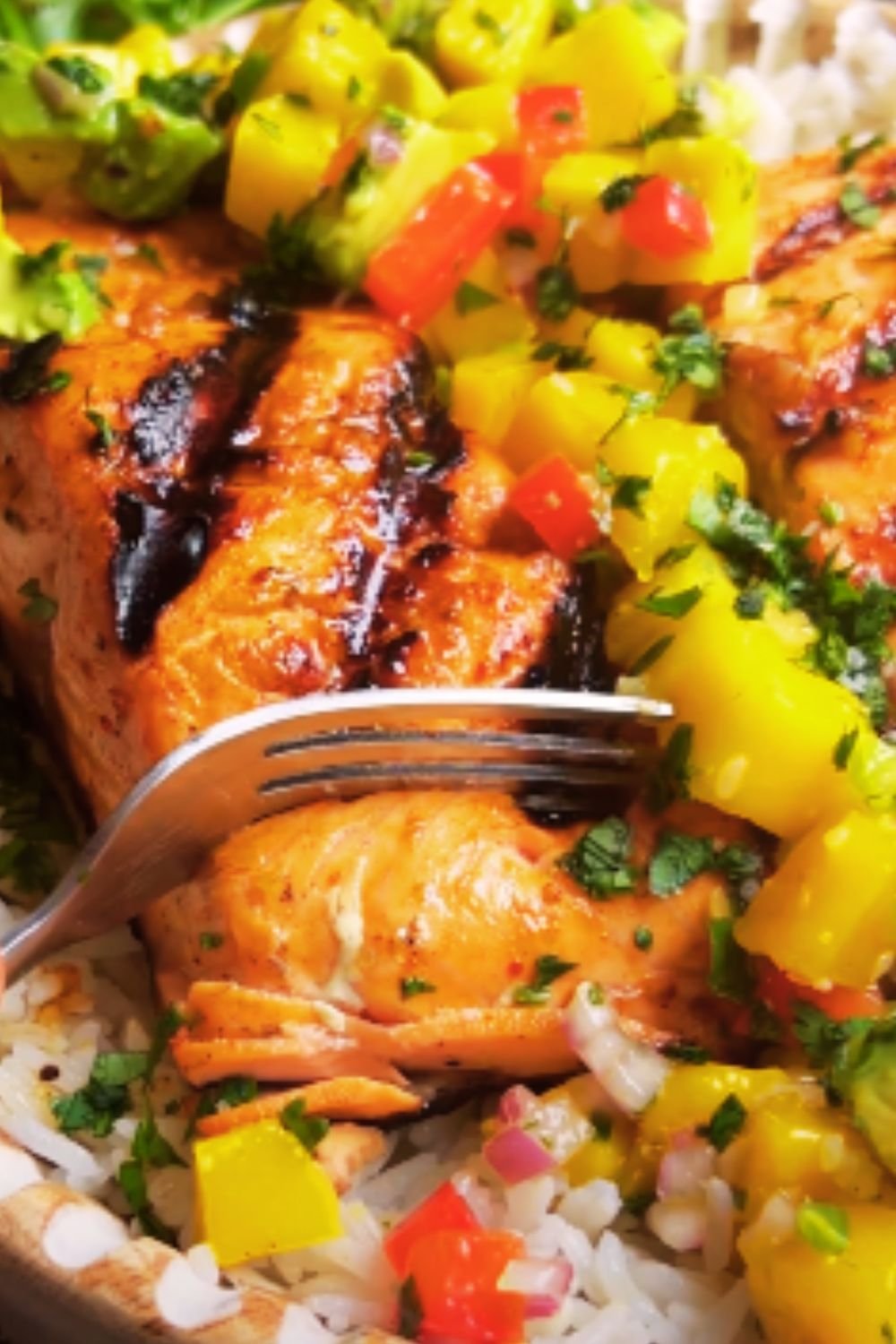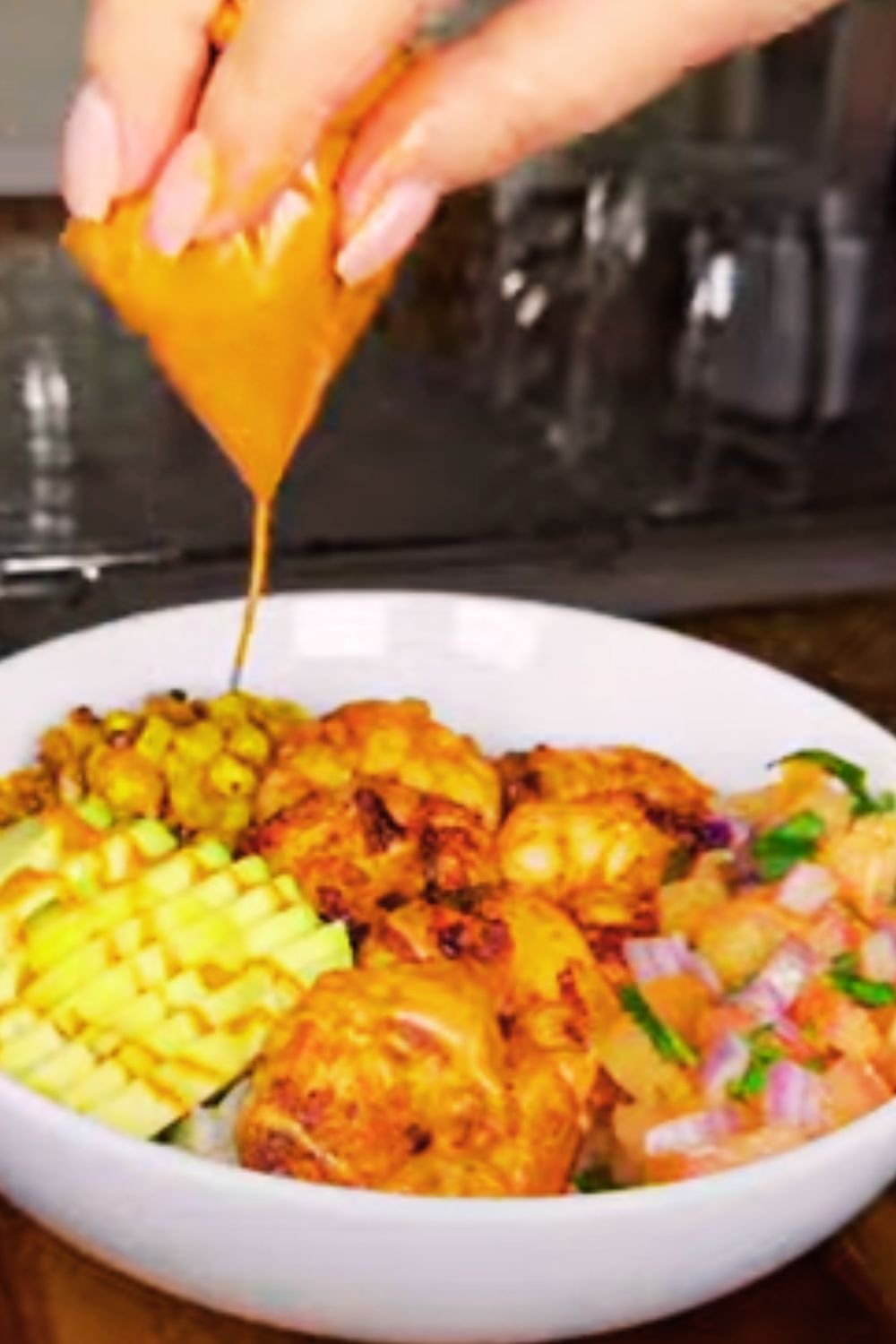There’s something magical about the combination of tender, flaky salmon and vibrant mango salsa that transports my taste buds straight to a tropical paradise with every bite. This pairing has become one of my go-to dinner options when I want to impress guests or simply treat myself to something special that doesn’t require hours in the kitchen.
I first discovered this delicious combination during a beachside vacation years ago, and I’ve spent considerable time perfecting my own version at home. The rich, buttery salmon creates the perfect canvas for the bright, zesty flavors of fresh mango salsa. The contrast between the warm, savory fish and the cool, sweet-tangy salsa creates a harmony of flavors that’s simply unforgettable.
What makes this dish truly spectacular is its versatility and health benefits. Salmon is packed with omega-3 fatty acids and high-quality protein, while the mango salsa delivers a powerful punch of vitamins and antioxidants. It’s a nutritional powerhouse disguised as an indulgent meal!
In today’s article, I’ll share my carefully perfected recipe for creating this restaurant-worthy dish in your own kitchen, along with tips and tricks I’ve gathered over years of making it. Whether you’re cooking for a special occasion or just wanting to elevate your weeknight dinner routine, this Salmon with Mango Salsa recipe is guaranteed to impress.
Why This Recipe Works
Before diving into the details, let me explain why this particular recipe stands out from others you might find:
- Perfect balance of flavors: The richness of the salmon is complemented by the sweet-tart-spicy notes in the mango salsa.
- Simple technique: The cooking method ensures moist, flaky salmon every time, even for beginners.
- Make-ahead components: The salsa can be prepared in advance, making dinner assembly quick and stress-free.
- Impressive presentation: With minimal effort, you’ll create a dish that looks like it came from a high-end restaurant.
- Nutritional powerhouse: High in protein, healthy fats, vitamins, and minerals without feeling like “health food.”
I’ve made this dish countless times, tweaking ingredients and methods until I achieved what I believe is the perfect combination. Let’s get started!
Ingredients You’ll Need
For the Salmon:
- 4 salmon fillets (6 oz each), skin-on preferred
- 2 tablespoons extra virgin olive oil
- 1 tablespoon fresh lime juice
- 2 cloves garlic, minced
- 1 teaspoon ground cumin
- 1 teaspoon smoked paprika
- ½ teaspoon ground coriander
- ½ teaspoon sea salt
- ¼ teaspoon freshly ground black pepper
- Fresh cilantro for garnish
For the Mango Salsa:
- 2 ripe mangoes, peeled and diced into ¼-inch cubes
- 1 small red bell pepper, finely diced
- ½ small red onion, finely diced
- 1 jalapeño pepper, seeded and minced (leave seeds in for extra heat)
- ¼ cup fresh cilantro leaves, chopped
- 2 tablespoons fresh lime juice
- 1 tablespoon extra virgin olive oil
- ½ teaspoon sea salt
- ¼ teaspoon freshly ground black pepper
- 1 ripe avocado, diced (optional but recommended)
Nutritional Powerhouse
One of the reasons I love this recipe is its impressive nutritional profile. Take a look at what this meal offers:
| Nutrient | Amount per Serving | Benefits |
|---|---|---|
| Protein | 34g | Supports muscle growth and repair |
| Omega-3 Fatty Acids | 1.8g | Anti-inflammatory, heart and brain health |
| Vitamin C | 85mg (95% DV) | Immune support, collagen production |
| Vitamin A | 865 IU (17% DV) | Eye health, immune function |
| Vitamin D | 11μg (55% DV) | Bone health, immune function |
| Potassium | 780mg (17% DV) | Blood pressure regulation, muscle function |
| Fiber | 4g | Digestive health, prolonged satiety |
| Vitamin B12 | 3.5μg (146% DV) | Energy production, nerve function |
*Values are approximate and based on using wild-caught salmon and including all ingredients listed.
Step-by-Step Instructions
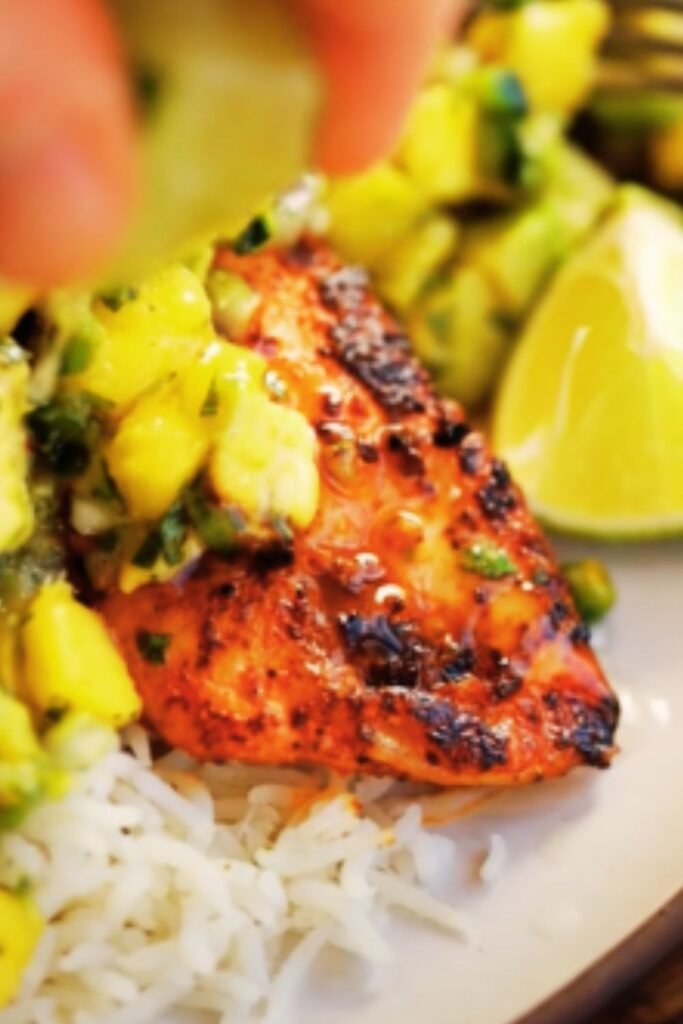
Preparing the Mango Salsa
- Dice the mango: Choose mangoes that yield slightly to gentle pressure. They should smell sweet at the stem end. Cut around the flat pit and score the flesh into a grid pattern before turning the skin inside out to create cubes.
- Prepare the vegetables: Finely dice the red bell pepper and red onion. For the jalapeño, remove seeds and membrane for milder heat or keep some for extra spice.
- Combine ingredients: In a medium bowl, gently combine the diced mango, bell pepper, red onion, jalapeño, and chopped cilantro.
- Add dressing: Drizzle with fresh lime juice and olive oil, then sprinkle with salt and pepper. Toss gently to combine.
- Let flavors develop: Cover and refrigerate for at least 30 minutes and up to 4 hours to allow flavors to meld. If adding avocado, fold it in just before serving to prevent browning.
Preparing the Salmon
- Create the marinade: In a small bowl, whisk together olive oil, lime juice, minced garlic, cumin, smoked paprika, coriander, salt, and pepper.
- Prepare the fillets: Pat salmon fillets dry with paper towels. This step is crucial for achieving a nice sear on the fish.
- Apply the marinade: Place salmon fillets on a plate or shallow dish, skin-side down if using skin-on fillets. Drizzle the marinade over the salmon, ensuring it’s well-coated. Allow to marinate for 15-30 minutes at room temperature.
- Preheat your cooking surface: If using an oven, preheat to 400°F (200°C). If grilling, preheat to medium-high heat.
Cooking the Salmon
Pan-Searing Method (My Preferred Technique):
- Heat the pan: Heat a large, heavy-bottomed skillet (preferably cast iron) over medium-high heat. Add 1 tablespoon of olive oil.
- Sear the salmon: Once the oil is shimmering, place salmon fillets skin-side down (if using skin-on). Press gently with a spatula for 10 seconds to prevent curling.
- Cook properly: Cook undisturbed for 4-5 minutes until the skin is crispy and the salmon has cooked about halfway up the sides.
- Flip and finish: Carefully flip the fillets and cook for another 2-3 minutes until the internal temperature reaches 125°F (52°C) for medium-rare or 130°F (54°C) for medium. The fish should flake easily but still be slightly translucent in the center.
- Rest before serving: Transfer salmon to a plate and let rest for 3-5 minutes before serving.
Oven-Baked Method:
- Prepare baking sheet: Line a baking sheet with parchment paper and place marinated salmon fillets skin-side down.
- Bake: Place in preheated 400°F (200°C) oven for 12-15 minutes, depending on thickness. Salmon is done when it reaches 125°F-130°F (52°C-54°C) internal temperature.
- Rest before serving: Allow to rest for 3-5 minutes before plating.
Grilling Method:
- Prepare grill: Oil the grill grates well to prevent sticking.
- Grill with skin: Place salmon skin-side down and grill for 4-5 minutes until skin is crispy.
- Finish cooking: Carefully flip and grill for another 2-3 minutes until desired doneness is reached.
- Rest before serving: Transfer to a plate and let rest for 3-5 minutes.
Plating and Serving
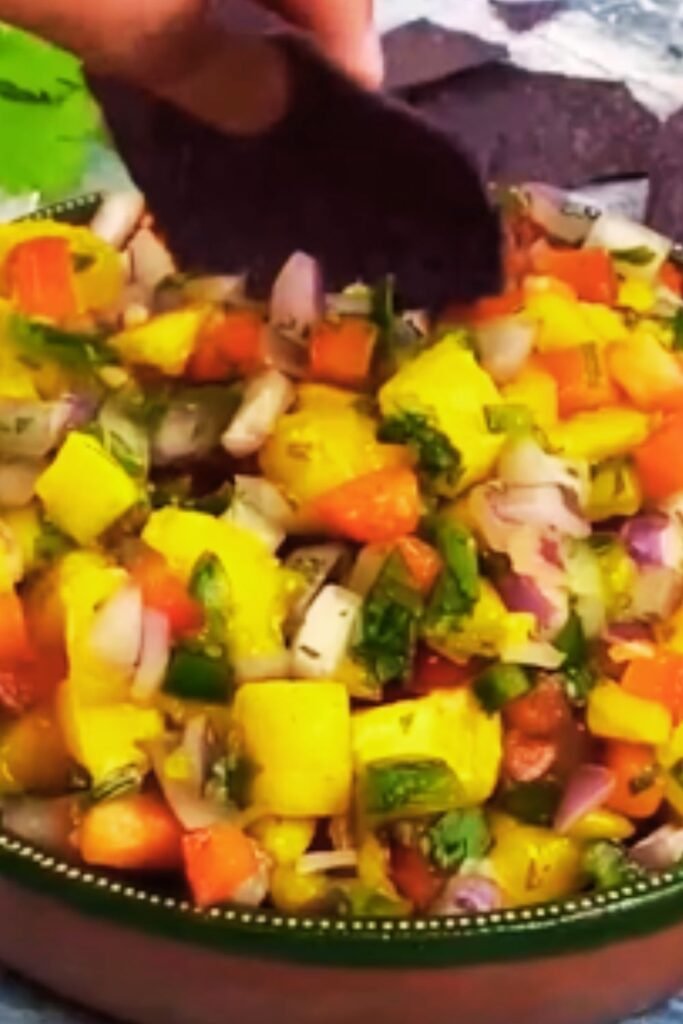
To serve this dish restaurant-style:
- Warm the plates: Professional chefs always serve on warm plates. Place your dinner plates in a low oven (170°F/75°C) for a few minutes before serving.
- Place the salmon: Position the salmon fillet in the center of the plate, skin-side down if you kept the skin on.
- Top with salsa: Spoon a generous amount of mango salsa over and around the salmon.
- Garnish: Add a sprig of fresh cilantro and a lime wedge for both presentation and an extra squeeze of acidity if desired.
- Final touch: Drizzle a small amount of high-quality extra virgin olive oil around the plate for a restaurant-worthy presentation.
Make It Your Own: Variations
Over the years, I’ve experimented with several variations of this dish that you might enjoy:
Spice Level Adjustments
- Mild: Omit jalapeño from the salsa and reduce black pepper
- Medium: Follow the recipe as written
- Spicy: Add an extra jalapeño with seeds or substitute with a hotter pepper like serrano
- Fire Level: Add a minced habanero or scotch bonnet pepper to the salsa
Alternative Fruits for the Salsa
- Pineapple: Substitute diced pineapple for the mango
- Peach: During summer, fresh peaches make an exceptional salsa
- Papaya: Offers a similar tropical flavor with a different texture
- Strawberry: For a surprising and delightful twist
Serving Suggestions
This salmon dish pairs beautifully with:
- Coconut lime rice
- Quinoa with herbs
- Roasted sweet potatoes
- Grilled asparagus
- Cucumber and avocado salad
- Fresh garden salad with citrus vinaigrette
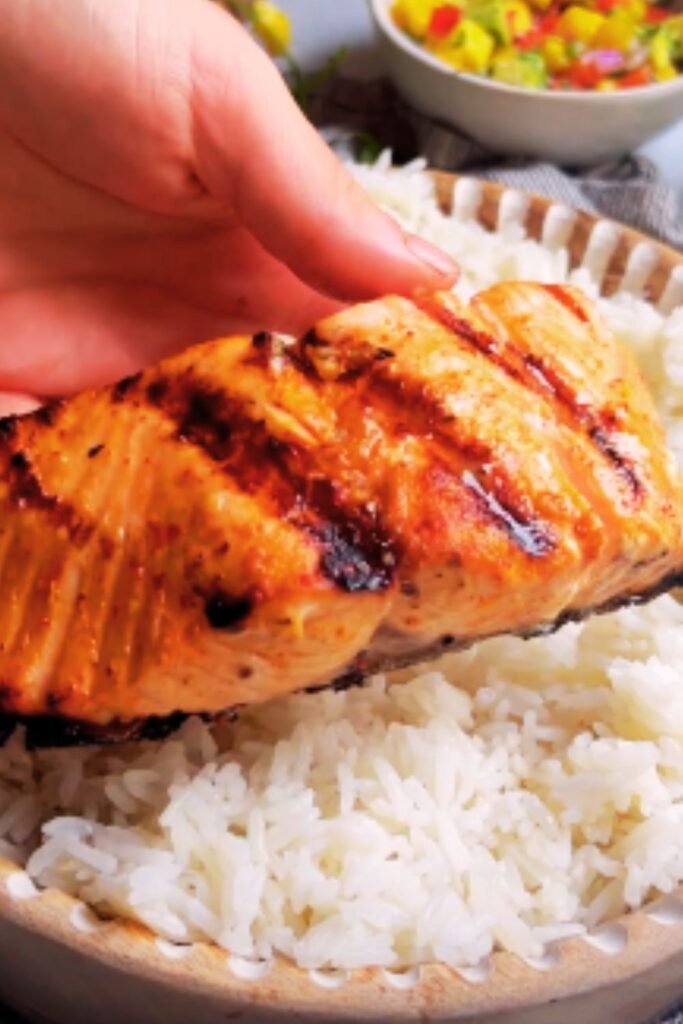
Common Mistakes to Avoid
In my years of preparing this dish, I’ve made (and subsequently learned from) several mistakes:
- Overcooking the salmon: This is the #1 error! Salmon continues cooking after being removed from heat. Take it off when it still looks slightly underdone in the center.
- Under-seasoning: Don’t be shy with salt and spices. Proper seasoning brings out the flavors of both the salmon and the salsa.
- Using unripe mangoes: The salsa relies on sweet, ripe mangoes. Unripe fruit will lack sweetness and have a tough texture.
- Skipping the rest period: Always let your salmon rest after cooking. This allows the juices to redistribute throughout the fish.
- Making salsa too far ahead: While it’s fine to prepare the salsa a few hours ahead, making it a day in advance can result in a watery texture and diminished freshness.
Storage and Reheating
Ideally, this dish is enjoyed fresh, but if you have leftovers:
- Salmon: Store in an airtight container in the refrigerator for up to 2 days. Reheat gently in a 275°F (135°C) oven until just warmed through, about 10-15 minutes.
- Mango Salsa: Will keep in the refrigerator for up to 2 days, though the texture may change slightly. Drain excess liquid before serving.
- Make-Ahead Strategy: If planning ahead, prepare the salsa up to 4 hours in advance (adding avocado just before serving) and marinate the salmon up to 30 minutes before cooking.
The Health Benefits Breakdown
This dish isn’t just delicious—it’s nutritionally balanced as well. Here’s a deeper look at why this meal deserves a regular spot in your dinner rotation:
| Component | Key Benefits | Why It Matters |
|---|---|---|
| Salmon | High-quality protein, omega-3 fatty acids, vitamin D, B vitamins | Supports heart health, reduces inflammation, promotes brain function |
| Mango | Vitamins A and C, fiber, antioxidants | Boosts immunity, promotes good digestion, supports eye health |
| Bell Pepper | Vitamin C, various antioxidants | Enhances iron absorption, supports immune function |
| Lime Juice | Vitamin C, antioxidants | Aids digestion, improves absorption of other nutrients |
| Avocado (optional) | Healthy monounsaturated fats, fiber, potassium | Supports heart health, helps absorption of fat-soluble vitamins |
| Olive Oil | Monounsaturated fats, vitamin E, antioxidants | Reduces inflammation, supports heart health |
| Cilantro | Vitamins A, C, and K, antioxidants | Helps remove heavy metals from the body, anti-inflammatory properties |
The Perfect Occasions
This recipe has been my go-to for numerous occasions:
- Date nights: Impressive yet easy enough to prepare while still focusing on your companion
- Summer dinner parties: The bright colors and flavors are perfect for warm weather entertaining
- Healthy weeknight dinners: Quick enough for busy evenings but special enough to brighten your routine
- Meal prep: Components can be prepared ahead for quick assembly
Sustainability Note
When shopping for salmon, I always try to make environmentally conscious choices:
- Look for wild-caught Alaskan salmon, which is managed sustainably
- If choosing farmed salmon, look for certifications like Aquaculture Stewardship Council (ASC) or Best Aquaculture Practices (BAP)
- Consider using the Seafood Watch app to make informed choices at the seafood counter
Sustainable choices not only help preserve our oceans but often result in better flavor and nutritional profile.
Questions & Answers
What type of salmon works best for this recipe? For this recipe, I prefer wild-caught salmon varieties like sockeye or coho for their firmer texture and robust flavor. King (Chinook) salmon is also excellent though more expensive. Farm-raised Atlantic salmon works well too and is often more budget-friendly. The most important factor is freshness – look for salmon with firm, moist flesh and no strong fishy odor.
Can I make this recipe ahead of time for a dinner party? Yes! The mango salsa can be prepared up to 4 hours ahead (add the avocado just before serving). For the salmon, I recommend marinating it ahead of time but cooking it just before serving. If you absolutely need to cook ahead, slightly undercook the salmon, then reheat it gently in a low oven (275°F/135°C) for about 10 minutes before serving.
How can I tell when salmon is perfectly cooked? Perfectly cooked salmon should flake easily with a fork but still have a slightly translucent center. For medium doneness, aim for an internal temperature of 125°F-130°F (52°C-54°C). The salmon will continue cooking after you remove it from heat. If you don’t have a meat thermometer, try the cake tester method: insert a metal cake tester or thin knife into the thickest part for 5 seconds, then touch it to your upper lip – it should feel warm but not hot.
Is there a non-spicy version I can make for kids? Absolutely! Simply omit the jalapeño from the salsa and reduce or eliminate the black pepper in both components. The natural sweetness of the mango will appeal to kids, and you can serve extra lime wedges on the side for adults who want more zing.
What can I substitute for mango if it’s not in season? When mangoes aren’t at their peak, peaches make an excellent substitute in summer. Pineapple works well year-round, and even sweet-tart apples mixed with a bit of orange can work in a pinch. Each alternative will create a different flavor profile but will still complement the salmon beautifully.
Can I use frozen salmon? Yes, high-quality frozen salmon can work well. Thaw it slowly in the refrigerator overnight rather than using quick-thaw methods. Pat it very dry before marinating and cooking, as previously frozen salmon sometimes releases more moisture.
How do I prevent my salmon from sticking to the grill? First, make sure your grill is very clean and well-oiled. Second, ensure the grill is properly preheated before adding the fish. Third, start with the salmon skin-side down and don’t try to flip it until it naturally releases from the grate. If you’re still having trouble, consider using a cedar plank or a fish grilling basket.
Can I make this into a complete meal prep for lunches throughout the week? This dish works surprisingly well for meal prep! Cook the salmon as directed but slightly underdone since it will continue cooking when reheated. Store the salmon and salsa separately, and prepare a batch of rice, quinoa, or roasted sweet potatoes as a base. Assemble the components just before eating, or gently reheat the salmon and base before topping with the cold salsa.
Final Thoughts
Creating the perfect salmon with mango salsa has been a journey of discovery for me. What began as an attempt to recreate a vacation memory has evolved into one of my signature dishes. The beauty of this recipe lies in its balance – the rich, tender salmon harmonizing with bright, zesty salsa creates a symphony of flavors that’s greater than the sum of its parts.
I encourage you to make this recipe your own. Adjust the seasonings to your preference, experiment with different fruits in the salsa, or try various cooking methods for the salmon. Cooking should be an adventure, and this dish offers plenty of room for creative expression while still providing reliable, delicious results.
Next time you’re looking for a meal that feels special without requiring hours in the kitchen, I hope you’ll give this salmon with mango salsa a try. It might just become your new favorite too!
